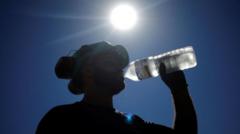The World Health Organization (WHO) has issued a critical call to action concerning the risks of extreme heat in workplaces, particularly as climate change leads to increasingly frequent heatwaves. In collaboration with the World Meteorological Organization, the WHO's recent report reveals that millions of workers globally face significant health threats due to heat stress, which can detrimentally affect both wellbeing and productivity.
This warning is notably the first extensive analysis focused on workplace heat stress since a 1969 report. Rüdiger Krech, the WHO's director for environment, climate, and health, describes the findings as a "wake-up call." He emphasizes the seriousness of the dangers posed by rising temperatures, which can result in heat-related illnesses such as strokes, kidney failure, and severe dehydration when body temperatures exceed 38C for sustained periods.
The past decade has recorded the hottest average temperatures ever, and 2024 is predicted to become the hottest year yet. In Europe, temperatures are reaching unprecedented highs, while regions like Africa and the Middle East are recording extreme conditions above 50C. The WHO contends that workplace productivity declines alongside rising temperatures, estimating that for every degree above 20C, productivity can decrease by 2%.
Moreover, the report notes that heatwaves can lead to increased workplace accidents. For instance, during the 2023 heatwave in Europe, a Swiss insurance fund reported a 7% rise in accidents when temperatures surpassed 30C, attributing this rise to issues like concentration and sleep disruption caused by extreme heat.
In response, several European nations are exploring measures to protect workers during peak heat periods. The Italian government recently enacted an emergency protocol to halt work during the hottest hours, and construction activities were paused in parts of Switzerland during severe heat. Trade unions, such as the Swiss union Unia, advocate for employer responsibility in ensuring safe working conditions, acknowledging the pressure on construction sites to meet deadlines.
Heat stress also threatens at-risk populations including the elderly, young, and chronically ill, necessitating adaptations in schools as well. Germany’s schools have historically implemented a system of "Hitzefrei," allowing children to leave when temperatures exceeded certain thresholds. However, with such temperatures becoming commonplace, schools are hesitant to frequently disrupt learning.
Recent advice for teachers in Switzerland suggested taking classes to swimming pools amid soaring temperatures, yet the ability to conduct all lessons in such settings is impractical. Education leaders, like Dagmar Rösler from the Swiss teachers' association, advocate for infrastructural improvements, including ventilation and air conditioning systems in schools to ensure a comfortable learning environment for children.
The WHO/WMO report underscores the need for comprehensive discussions involving all stakeholders in the adaptation process. Krech suggests practical considerations, such as re-evaluating school uniforms in light of severe heat events, to foster cooler and more bearable conditions for both students and teachers.
Adaptation will require significant financial investment, yet Krech warns against the shortsightedness of neglecting climate change preparation. Without proactive measures, the repercussions of heat stress on worker productivity and health could lead to larger economic losses, making it imperative for governments to prioritize adaptation initiatives alongside other pressing financial commitments.
















